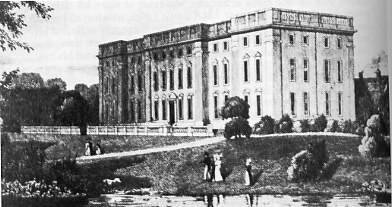Ellen and Jim Have a Blog, Too
We are two part-time academics. Ellen teaches in the English department and Jim in the IT program at George Mason University.


_Mansfield Park_ · 21 March 06
Dear Jennica,
I’m glad to hear you’ve started the book. Austen’s characters are often related in complicated various ways to one another. When I taught Persuasion I made a family tree of the character’s relationships for my students. They said they found they needed one. So your experience is not uncommon. Women aren’t embedded in family groups in the way they once were.
In Mansfield Park we have three sisters in the older generation: Lady Bertram, Mrs Norris, and Mrs Price. The way the sisters are named before marriage in the first paragraph of the novel tell us that Mrs Norris (Miss Ward) is the oldest; Lady Bertram (Miss Maria Ward), the middle sister; and Mrs Price (Miss Frances), the youngest. Sir Thomas and Lady Bertram are the uncle and aunt of Fanny Price (our heroine); they take her in to relieve her mother (Mrs Price) of the cost and burden of her maintenance and education. Mrs Norris likes to think she is a generous woman and it was partly her idea to bring Fanny to Mansfield Park; however, she never meant to take Fanny in as Mrs Norris is miserly. Mrs Norris just promised this to get Sir Thomas to take Fanny and make herself look good; Mrs Norris is a hateful hypocrite who seeks to control and to bully others in order to assert her pride. She’s also a petty thief (as was one of Austen’s nastier aunts).
When a group of us on Austen-l and again Litalk-l read Mansfield Park together, I wrote a number of postings which I put on my website. They are prefaced by links to Lovers Vows, the play the characters in Mansfield Park put on, a review of the recent film adaptation, and postings on literary criticism on Mansfield Park; and they are arranged in accordance with what chapters they are on:
I also drew the calendar underlying the novel out from it, and if you read the calendar after you finish the novel, you will see it puts the story in chronological order:
Perhaps look at some of the above when you are half-way through with the novel, or wait until you’ve finished it.
In 1806 (after Jane Austen left Bath and before she settled into Chawton), she and her mother and sister visited Stoneleigh Abbey; one of the Austen relatives hoped to inherit it. She describes her experience of it in a letter to her sister, Cassandra, as follows:
I do not fail to spend some part of every day in the kitchen garden, where the quantity of small fruit exceeds anything you can form an idea of. This large family, with the assistance of a great many blackbirds and thrushes, cannot prevent it from rotting on the trees. The gardens contain four acres and a half. The ponds supply excellent fish, the park excellent venison; there is great quantity of rabbits, pigeons, and all sorts of poultry. There is a delightful dairy, where is made butter, good Warwickshire cheese and cream ditto. One manservant is called the baker, and does nothing but brew and bake. The number of casks in the strong-beer cellar is beyond imagination …
Now I wish to give you some idea of the inside of this vast house – first premising that there are forty-five windows in front, which is quite straight, with a flat roof, fifteen in a row. You go up a considerable flight of steps to the door, for some of the offices are underground, and enter a large hall. On the right hand is the dining-room and within that the breakfast-room, where we generally sit; and reason good, ‘tis the only room besides the chapel, which looks towards the view. On the left hand of the hall is the best drawing-room and within a smaller one. These rooms are rather gloomy with brown wainscot and dark crimson furniture, so we never use them except to walk through to the old picture gallery. Behind the smaller drawing-room is the state-bedchamber – [Page 166] an alarming apartment, with its high, dark crimson velvet bed, just fit for an heroine. The old gallery opens into it. Behind the hall and parlours there is a passage all across the house, three staircases and two small sitting-rooms. There are twenty-six bedchambers in the new part of the house and a great many, some very good ones, in the old. There is also another gallery, fitted up with modern prints on a buff paper, and a large billiard-room.
It’s thought that the imaginative vision of Mansfield Park as a place which dominates the novel is based on Austen’s memories of this place. Here’s an old print:
Rozema had the above picture in mind when she photographed the building she used for MP in her film.
I hope you enjoy reading the book. And I hope you eventually see some of the film adaptations of Austen’s novels. I like the first film adaptation of Mansfield Park too (it was done in 1983), and I write about it in Jane Austen on Film; or, How to Make a Hit.
Sophie
--
Posted by: Ellen
* * *
Comment
commenting closed for this article

